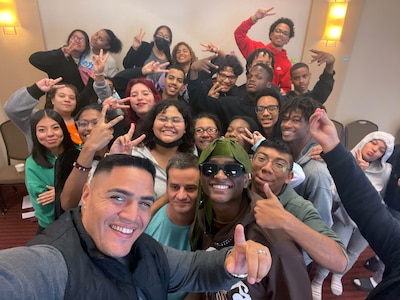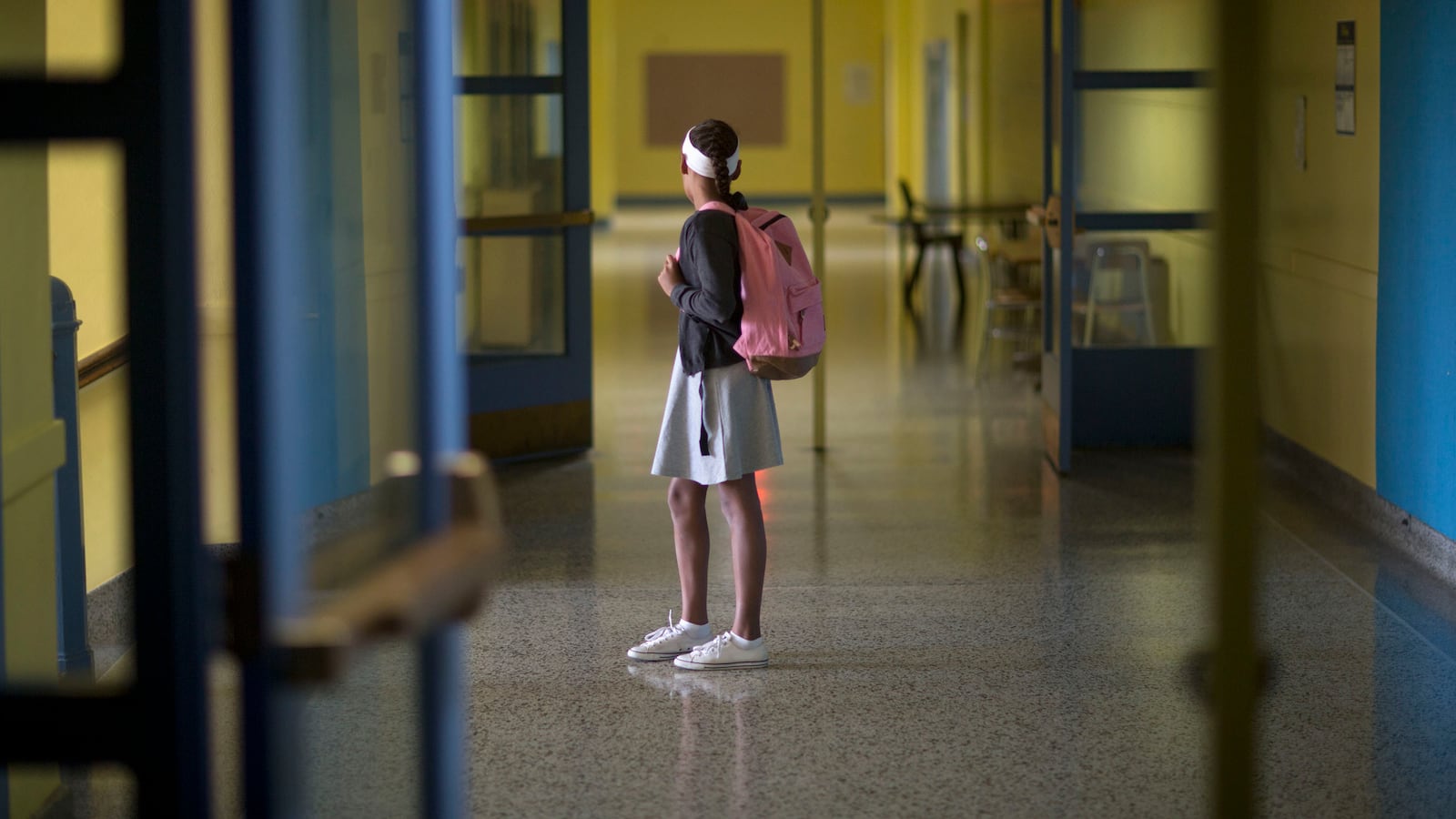Bronx Principal David Liu did not notice an abrupt change in attendance when students returned to in-person learning three years ago after pandemic campus closures. Instead, the problem became clearer to him as the year progressed.
Students and staff at Gotham Collaborative High School became fatigued by five-day school weeks. Child tax credits and supplemental unemployment benefits also began to wane, forcing parents back into the workplace and requiring students to take on more responsibilities at home.
“The grind of what school was started to hit students at different times of the school year,” he said. “That’s when chronic absenteeism became kind of more like this slowly growing thing in our school.”
Now, the school has begun to crack the code on chronic absenteeism, a problem challenging school districts across the country. Administrators implemented a data system to better track students’ attendance and leverage staff and community organizations to counsel those at risk of chronic absence. The school even offers incentives to get students to show up, such as early-morning breakfast raffles or day trips.
Schools across New York City have introduced new initiatives to address the longstanding issue. Some have started to use restorative justice as a guiding principle in group interventions that target chronically absent students, rather than resorting to more punitive measures. Increasingly, schools are enlisting other students to encourage their friends to attend school regularly.
Most districts, including New York City, consider a student chronically absent if they miss at least 10% of the school year, whether those days are considered excused, unexcused, or part of a suspension. With a 180-day academic calendar, that is 18 missed days of school.
The citywide chronic absenteeism rate stood at about 25% before the pandemic. Once students returned to in-person learning in 2021, the city’s share of chronically absent students jumped 15 percentage points. While schools have made progress to lower that rate over the years, citywide chronic absenteeism still hasn’t returned to what it once was. Nearly 35% of public school students were chronically absent last school year, according to data recently released in the Mayor’s Management Report.
Though higher-poverty schools began closing the gap on chronic absenteeism in 2022-23, that gap still hovered about 14 percentage points higher than their counterparts. As a result, more and more schools have found themselves addressing issues that exist beyond the school’s environment, such as students’ access to health care, child care, and transportation.
That is why some teachers and school administrators say tackling chronic absenteeism is so challenging – it often requires a deeper knowledge of the students and families that they serve. In its 2022-23 Comprehensive Education Plan, Gotham Collaborative cited “not knowing our students well” as the root cause of the school’s chronic absence problem.
And while data collection often serves as a first step to addressing chronic absenteeism, creating plans that lead to improvement requires people, said Kim Nauer, an education fellow at The New School’s Center for New York City Affairs who has looked at how poverty contributes to chronic absence.
“Every single one of those numbers needs to be a kid and a name and a parent and a person attached to them,” she said. “Otherwise you’re not going to make progress in any sustained way. Like robocalls [are] useless.”
Using data to target specific student groups
Gotham Collaborative High School, which served a little over 300 students last school year, had already viewed chronic absenteeism as an issue worthy of intervention before the pandemic. The school’s pre-pandemic chronic absenteeism rate was already higher than the average, at about 56%, and it then grew to 61% in 2020 when the pandemic forced school closures across the city.
During the 2022-23 school year, however, the high school’s rate of chronically absent students dropped to roughly 29%, its lowest in years.
Tackling the issue has taken years of targeted work and has relied on a data system the school created, grouping students into four buckets according to their absences. Each group receives certain interventions depending on the severity of their record. Those are provided through several support teams that might include peer mediator ambassadors, school counselors, and a social worker.
Sometimes intervention looks like an in-depth, individualized assessment of a student and their needs, or a home visit with a student and their family. But other times it may look like a school social for students who feel that they don’t have a strong network of friends, or an early-morning breakfast raffle.
Addressing the needs of students whose attendance and academic performance didn’t raise warning flags was critical, Liu said. Before introducing the new system, he said, the school identified only a small selection of students – those who came in the least, or about half of the school year, and those who had near-perfect attendance. Changing their focus helped shift the school toward lower instances of chronic absence, he believes.
“This was a main ‘aha’ moment for us,” he said. “These are our students that are coming 80% of the time, four out of five times a week, they might be B-average students. It sparked a lot of conversations about how do we show them that what they’re doing is not meeting what they can be doing and their potential?”
Many schools with a high share of chronically absent students use some variation of Gotham Collaborative’s data tracking system.
New York City schools receive weekly automatic reports that list students who have missed five or 10 school days. Schools can also print additional reports that show all students who have missed school five or 10 times, or chronically absent students from the previous school year. The reports are most effective when schools create workflows to immediately address what they are seeing in the data, said a spokesperson for the education department.
Hedy Chang, director of Attendance Works, a national and state initiative to address the issue, also noted that early intervention is important. When she and other researchers began studying chronic absence using the current, widely adopted 10% rule, she said one of its main purposes was to serve as an early-warning metric. So if a student misses two days of school in a month, she said, that should alert teachers and staff that a student is in need of support.
“I don’t want you to wait til 17 days to notice that things are a challenge,” Chang said, in reference to annual absences. “Or even in the first month, if it’s 10 days, that’s a problem.”
Using peer-to-peer support to overcome chronic absenteeism
Researchers like Chang and Nauer often examine chronic absenteeism among younger students because it is more representative of families’ circumstances. A 5-year-old, for example, isn’t missing school on their own accord, Chang said.
But for teens, chronic absenteeism comes with its own set of complexities. Liu has noticed that some of his students may miss school due to working long hours or having to bring younger siblings to and from school. Some may choose not to show up to avoid conflict with friends, he said.
And because the conversations that staffers have with students inevitably look different than those that students might have with people closer to their age, Liu is now focusing on tapping students’ ability to deeply connect with their peers to curb chronic absence.
“Every year we get older, but the kids stay the same age,” he said. “So every year the staff gets one year removed from being generationally, culturally relevant.”
At The International High School for Health Sciences – where all students are newly arrived immigrants – students may also grapple with other hurdles that affect engagement, such as learning English for the first time, or preparing for standardized tests unfamiliar to them, according to administrators at the school. Yet the high school’s chronic absenteeism rate during the 2022-23 school year fell to 29.5%, nearly cutting its rates from the previous two years in half.
In 2018, the school began using restorative justice — a practice that the school has used in lieu of other disciplinary measures since it opened over 10 years ago – to address chronic absenteeism, administrators say. A chronically absent student – typically in their final year of high school – sits down with a group of their closest friends, a teacher that they have a strong relationship with, and the assistant principal. The group discusses the student’s strengths, reasons for why they don’t show up at school, and how others in the group can support them moving forward.
International High School also receives extra support from staff at Queens Community House, the school’s community-based partner. Now in its third year, the partnership is funded through NYC Community Schools, a grant-based program that extends to about a third of the city’s more than 1,500 schools.
Queens Community House provides services such as tutoring outside of regular school hours – particularly during Regents season – and events that range from self-care workshops to game nights. Communicating with families, however, is one of its primary functions, said the school’s Community Schools Director Lizbeth Mendoza.
“The framework for a lot of these conversations is building relationships,” she said. “So I’m actually the person that sends out the message letting a parent or guardian know that their student was absent at the end of the day.”

At the High School for Teaching and the Professions in the Bronx, groups of older mentors and younger mentees start pairing together in October. The mentors, typically 11th or 12th graders, receive training in their own classes on how to support their mentees, whether that be through engaging in activities together or talking through the mentees’ experiences.
“They go in and they really create this bond,” said Principal Roberto Hernandez. “And what I found within the last two years was a sense of ownership that our mentors are having for their mentees.”
This sense of commitment has trickled into other areas of focus for the school, like attendance, Hernandez said. For some students, it has also created a sense of commitment to the school at large: Two of the high school’s guidance counselors are former students. Now that the school has a designated guidance counselor for every grade level, Hernandez said it is easier for the administration to connect with individual students.
“It’s not just teaching, it’s getting to know them and letting them get to know you, and they love it,” he said. “And I think that’s all contributing to where we are today.”
Mia Hollie is a data intern at Chalkbeat based in New York City. You can reach Mia at mhollie@civicnews.org .

